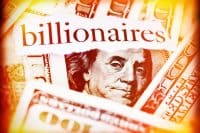Stocks decided to take a breather at the end of May, bringing up many questions ahead of summer about just how strong and powerful this bull market can remain after six years. The bad news is that each rally feels like it reaches exhaustion quickly. The good news is that investors have lined up in droves for almost four years now to buy their favorite stocks on every pullback.
24/7 Wall St. has looked closely at which stocks leading the market and which are hurting it. With a 2015 projection of 19,142 for the Dow Jones Industrial Average (DJIA), our initial estimate was that the Dow might gain 7% or so in 2015, with a handy portion of that coming from dividends.
It turns out that six of the 30 Dow stocks are hurting the broader index so far in 2015. Now that May has come to an end, 12 of the 30 Dow stocks are running in the red with negative performance, if you include their dividend payments. The other 18 Dow stocks were positive. The median loss of the 12 losers was 6%, while the median gain among the 18 winners was right at 7%.
According to IndexArb.com, each of the six Dow stocks hurting the market also have average index weightings since the Dow is a price-weighted index rather than a market cap-weighted one. 24/7 Wall ran the year-to-date performance of each of the six worst DJIA losers, and we included the loss and the weighting in the Dow (from IndexArb).
ALSO READ: 5 Key Analyst Stock Picks With 50% to 100% Upside (or Even More)
The losers in order of worst performance (worst to least-bad) were as follows:
- American Express Co. (NYSE: AXP)
- Procter & Gamble Co. (NYSE: PG)
- Wal-Mart Stores Inc. (NYSE: WMT)
- Exxon Mobil Corp. (NYSE: XOM)
- Chevron Corp. (NYSE: CVX)
- Caterpillar Inc. (NYSE: CAT)
When 24/7 Wall St. gave its indication of a 19,142 peak in the Dow in 2015, we also ran a bull and bear analysis for each of these Dow giants. Some have done exactly as expected, but some have offered surprises as well.
American Express
> 2015 YTD: -13.78%
> Dow Weighting: 2.95%
American Express just cannot catch a break in 2015. Its dividend hike is not enough to entice buyers, but the good news is that its valuation is getting dirt cheap. Fresh news that President Ed Gilligan died suddenly on a flight at age 55 has not helped matters. Neither has the loss of Costco. 24/7 Wall St. even highlighted five reasons AmEx shareholders are suffering.
American Express shares were recently trading at $79.72. The stock has a consensus analyst price target of $86.04 and a 52-week trading range of $76.53 to $96.24. Its market cap is $81 billion, and the yield is still a paltry 1.4%. The AmEx bull/bear analysis called for a 7.2% gain in 2015.
Procter & Gamble
> 2015 YTD: -12.63%
> Dow Weighting: 2.90%
This is a great company with great brands, making it the largest consumer products giant in the world. Still, it has become too hard to operate a giant of its size with so many brands. So the company is restructuring. It is selling Duracell to Warren Buffett and Berkshire Hathaway, and it has a lot of room to improve. It also has to learn how to combat currency headwinds. Despite P&G’s problems, it is now equal to Kimberly-Clark (or better) in the 10 stocks to own for the next decade. Its dividend ambitions are also expected to keep growing.
Procter & Gamble shares were at $78.39 to end out on May, below the consensus price target of $87.56. The stock has a market cap of $215 billion and a 52-week trading range of $77.29 to $93.89. P&G yields 3.3% now. The bull/bear analysis here called for a 3.8% gain in 2015.
ALSO READ: Has the Endless Growth of Dividends and Buybacks Peaked?
Wal-Mart
> 2015 YTD: -12.45%
> Dow Weighting: 2.75%
Wal-Mart may be a large holding of Warren Buffett, but the world’s largest retailer keeps having issues. You would think a strong dollar would help its profits with lower product costs, but that may also be capping its sales growth. Wal-Mart also keeps fighting the endless growth of dollar stores. What the next driving force will be remains up in the air, and shareholders have decided to step back. If wage pressures keep rising in the United States, it is going to pressure Wal-Mart’s operating costs — and whether more consumer dollars would offset the higher costs remains to be seen.
Shares of Wal-Mart were at $42.27 on Friday’s closing bell, with a market cap of $243 billion. The consensus analyst price target is $80.57, and the 52-week trading range is $72.61 to $90.97. Its yield is roughly 2.6%. Our Wal-Mart bull/bear analysis called for a loss of 1.9% in 2015.
Exxon Mobil
> 2015 YTD: -6.38%
> Dow Weighting: 3.16%
One of the best oil and gas companies in the world, Exxon is also the largest of all. Still, lower oil prices are hurting the company and the group as a whole. Due to the long-term fundamentals, this was renamed as one of the 10 stocks to own for a decade — just don’t expect that share price to launch any time soon. There may still be more risk in the oil patch, and Exxon may decide that it wants to gobble up smaller oil field owners if their stocks stay cheap or get battered further. To prove how strong this is even with lower oil prices: Exxon was able to raise its dividend.
Exxon shares were trading at $85.20, compared to the consensus price target of $93.61. The company has a market cap of $356 billion, and shares are near the lower end of the 52-week trading range of $82.68 to $104.76. Exxon’s recent dividend hike and a lower share price generate a 3.4% yield for new investors. The Exxon 2015 bull/bear analysis called for a 9% gain this year.
Chevron
> 2015 YTD: -6.36%
> Dow Weighting: 3.82%
Chevron has the same sector woes as Exxon, but Chevron decided that it had better not raise its dividend just yet. Chevron posted lower revenues and earnings, just like Exxon. The valuations in the sector are so varied that looking cheap in share prices might not be cheap based on historical price to earnings (P/E) valuations.
Shares of Chevron were trading hands at $103.00, within a 52-week trading range of $98.88 to $135.10. The consensus price target is $114.09, and the market cap is almost $194 billion. Chevron did not raise its dividend, but due to its lower price it now generates a 4.2% yield. The Chevron bull/bear analysis called for a 13% gain in 2015. Needless to say, oil is going to need to seriously recover for that gain to be seen. Analysts have since tempered expectations handily.
Caterpillar
> 2015 YTD: -5.24%
> Dow Weighting: 3.16%
Caterpillar faces growth issues in all the so-called growth markets around the world. Mining and infrastructure are serious issues that helped act as a driver, but now they are a load stone. Currency issues are also present, even though the company overcame much of the concerns. Caterpillar’s Machinery, Energy & Transportation segment had a decline in revenue, and Caterpillar used only $400 million in cash under the $10 billion buyback plan to buy shares last quarter.
Shares of Caterpillar closed out May at $85.32, within a 52-week trading range of $78.19 to $111.46. The consensus price target is $84.37, and the market cap is almost $51 billion. Caterpillar now has a dividend yield of 3.2%. The bull/bear outlook for 2015 expected a 19% gain in 2015, but that has so far been way out of reach.
ALSO READ: 10 Stocks to Own for the Next Decade
The Dow was up 2.1%, if you include the dividends paid in. The SPDR Dow Jones Industrial Average ETF Trust (NYSEMKT: DIA) and the raw index performance was up 1.05% as of the end of May.
The Average American Has No Idea How Much Money You Can Make Today (Sponsor)
The last few years made people forget how much banks and CD’s can pay. Meanwhile, interest rates have spiked and many can afford to pay you much more, but most are keeping yields low and hoping you won’t notice.
But there is good news. To win qualified customers, some accounts are paying almost 10x the national average! That’s an incredible way to keep your money safe and earn more at the same time. Our top pick for high yield savings accounts includes other benefits as well. You can earn up to 3.80% with a Checking & Savings Account today Sign up and get up to $300 with direct deposit. No account fees. FDIC Insured.
Click here to see how much more you could be earning on your savings today. It takes just a few minutes to open an account to make your money work for you.
Our top pick for high yield savings accounts includes other benefits as well. You can earn up to 4.00% with a Checking & Savings Account from Sofi. Sign up and get up to $300 with direct deposit. No account fees. FDIC Insured.
Thank you for reading! Have some feedback for us?
Contact the 24/7 Wall St. editorial team.





